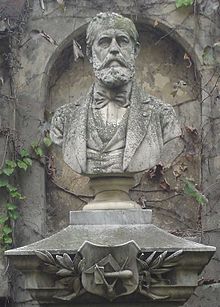Karl Storck
Karl Storck | |
|---|---|
 Bust of Karl Storck by Frederic Storck, at the Evangelical Cemetery in Bucharest | |
| Born | May 21, 1826 |
| Died | March 30, 1887 (aged 60) |
| Resting place | Evangelical Lutheran Cemetery, Bucharest |
| Nationality | Hessian, Romanian |
| Known for | sculpture, engraving, art theory |
| Movement | Academic |


Karl Storck (1826–1887) was a Hessian-born Romanian sculptor and art theorist.
Biography
Karl Storck was born on in Hanau, Grand Duchy of Hesse.[1] Having been trained and working for a time as an engraver, he became sculptor only later.[1] He studied in Paris, from where he was driven out by the French Revolution of 1848.[1] He settled in Bucharest in 1849, and spent the years 1856–1857 in Munich where he trained as sculptor.[1] In 1865 he became the first professor of sculpture at the Fine Arts Academy in Bucharest, becoming the most prominent figure and main developer in this early period of modern Romanian sculpture.[2][3]
His sons, Carol Storck (1854–1926) and Frederic Storck (1872–1924), were also noted artists.
Notable students
List of works
Sculptures and monuments
- Domniţa Bălaşa, Spătarul Mihail Cantacuzino
- Statue of Carol Davila
- Minerva încununând artele și știința
- The iconostasis of Viforata Monastery (15th century)
- Bas-reliefs on the facade of the University of Bucharest (destroyed by the Allied bombing of Bucharest in World War II)
- Facade and interior of the Suțu Palace
Portraits
- Bust of Grigore III Ghica of Moldavia, in Iași
- Busts of Theodor Aman, Alexandru Ioan Cuza, Mihail Kogălniceanu, C. A. Rosetti, Elena Cuza
See also
Notes
References
- Jane Turner (1996). The Dictionary of Art. Grove's Dictionaries. ISBN 9781884446009.
- Eugene K. Keefe (1972). Area Handbook for Romania. U.S. Gov. Print. Off.
- Constantin Daicoviciu (1966). Romania: Geography, History, Economy, Culture: Geography, History, Economy, Culture. Meridiane Pub. House.
External links
- (in German) Bildhauerei
Further reading
- Marin Mihalache, Sculptorii Storck ("The Storck Sculptors"), Editura Meridiane, Bucharest, 1975, LCCN: 75409215, LC: NB933.S83 M54
